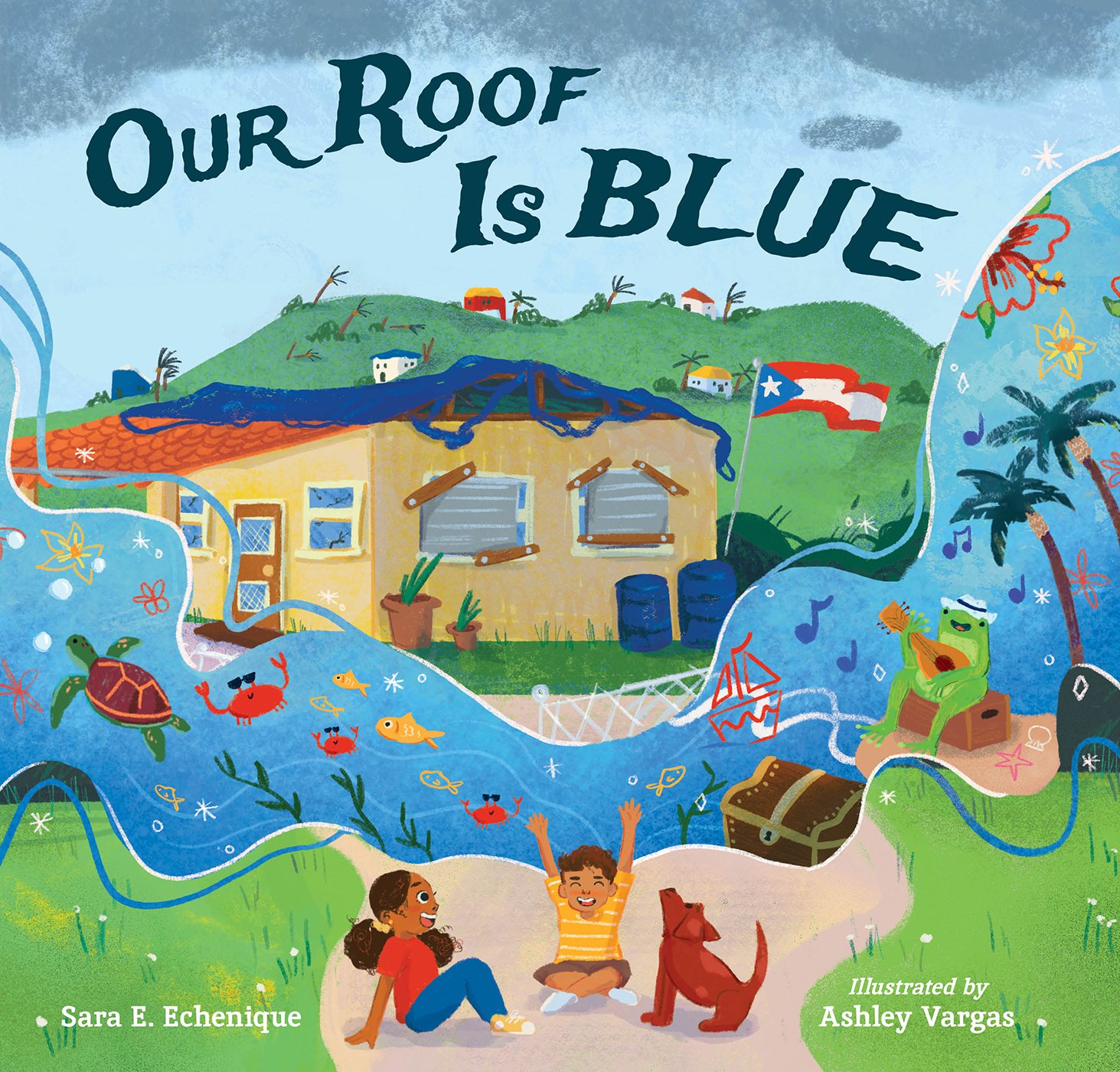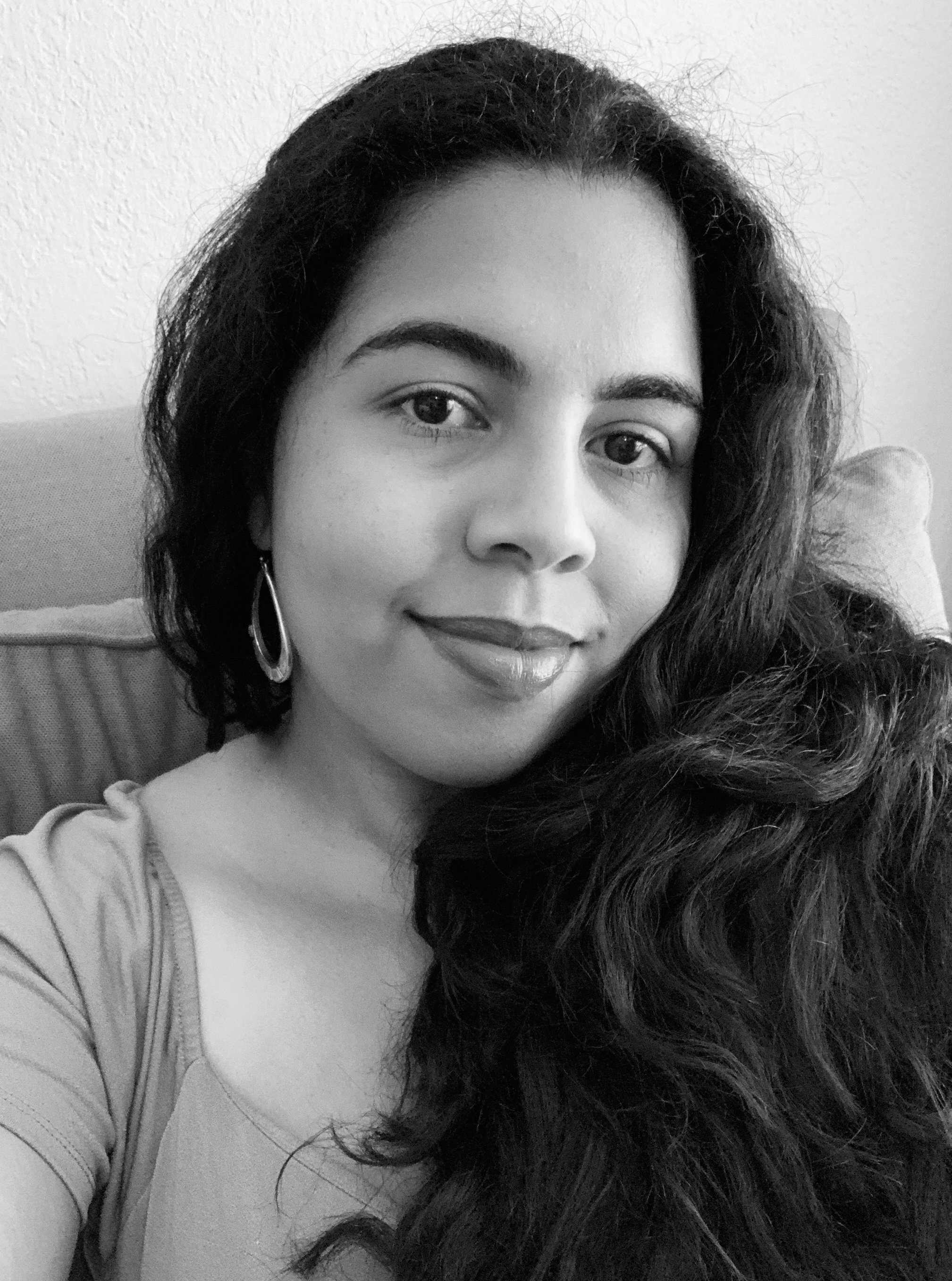Our Roof is Blue opens to a sun-yellow house in what appears to be un campo. Its front windows are cracked, and two others are boarded up with metal shutters. The flag of Puerto Rico is staked on the ground. In the distance are mountains and, if you peer closely, you’ll notice some trees are down.
In front of the yellow house, just beyond the entrance gate, a girl and her brother are feeding chickens.
“Our roof is blue, azul,” the little girl narrates. “But not cerulean like the sky, or an ocean aquamarine. It is a deep, bright blue like the feathers of a peacock or a blue macaw.”
A temporary blue tarp has replaced the siblings’ old white-gray roof after it was ripped away by Hurricane Maria. The keenly observant girl picks up on the differences. Their original roof used to keep the cool in, and didn’t really allow for the pitter-patter sounds of rain. This new roof, though, holds a puddle so large that their mother has to push it with a broom so water doesn’t dump in on them all.
And it is underneath this new roof that the girl detects a major change in her brother, Antonio. She used to fall asleep to his magical stories. But his tales have ceased.
Antonio hasn’t spoken a word since the storm.
Written by Sara E. Echenique and illustrated by Ashley Vargas, Our Roof is Blue is a tender picture book about resilience and rebuilding through the eyes of two Puerto Rican siblings. The story, out now from Charlesbridge, also speaks to the trauma that can be experienced from a natural disaster. The book also has a Spanish version—Nuestro techo es azul.
Puerto Ricans inspired her picture book debut, Echenique told Latinx in Publishing in a recent interview. The author and lawyer was born in Puerto Rico and now lives in South Florida, but her parents and extended family still live on the island.
“They were there during Hurricane Maria,” Echenique said of some of her relatives, including her parents. “And for those of us who were not on the island—part of the diaspora—it was just the most heart wrenching experience I think I’ve ever had.”
She recalled how difficult it was not knowing how her family was during Maria. She’d spend hours on the Internet, searching for information and the “David Begnauds of the world” who would post updates on social media. “We were lucky enough that they made it through the hurricane, but then all of the kind of after-effects were just so tragic,” she said.
At the time, Echenique’s children were still young. She said she began thinking of how they would have processed a natural disaster like this. “I tried to think of it through the eyes of the child, and that’s kind of where it originated,” she said of the idea for Our Roof is Blue.
Then when she was able to visit Puerto Rico a few months after Hurricane Maria, Echenique saw that people were still living without electricity, and all these “horrific things that were compounding on each other.”
Her biggest impression, though, was the number of homes that lacked a roof.
“So as you drive you would just see blue roof, after blue roof, after blue roof, after blue roof,” she said. “I was just blown away because these roofs are not intended to be permanent roofs. These tarps are intended to be 30-day temporary tarps. They’re not made for heat. They’re not made for withstanding long rain or wind or anything like that. They’re truly supposed to be temporary.”
And yet, Echenique noted, there are many homes on the island today that are still using tarps as permanent. For the author, the tarp in Our Roof is Blue is a symbol of failure and hope.
In the book, the unnamed narrator, her brother, and their parents prepare for the storm. Through Vargas’ vivid and scribbly illustrations and Echenique’s clear words, readers are given a window through the preparation before an impending hurricane, and the fear during one. “We thought we were ready for anything that could blow our way,” the girl narrates. “But then… the storm blew loud and fierce all day and all night… I acted brave so I would feel brave. Inside, my heart was pounding.”
The story also touches on the power of community in helping to rebuild, and readers feel hope by the end.
“Young readers, she said, may have many takeaways. The biggest one she hopes they leave with is that Antonio and his sister are like them, regardless of what their lived experiences are.”
One of the most heartening elements of this story is the relationship between the unnamed protagonist and her brother, Antonio. Echenique said this sibling bond was drawn from her own relationship with her siblings.
“And then for me, the central focus [of the book] had to be one of hope, and one of resiliency, because I think that truly defines Puerto Ricans—especially those on the island,” she said. “Because of everything they’ve been through, they have no choice but to be like that. I wanted it to be a celebration of that and not necessarily a tragedy, even though of course there were a lot of tragedies that came out of it.”
Trauma can manifest in many different ways. In Our Roof is Blue, we see the main character’s brother, Antonio, stop speaking. Echenique recalled reading many news articles about Hurricane Maria, and one was about a young girl who hadn’t spoken since the storm. The author wondered how the girl would proceed. “Obviously there’s no follow-up in those types of stories,” she said. “In my mind, I wanted to see her on the other end of it.”
From Echenique’s perspective, stories were such a central feature of how her character, Antonio, expressed himself.
“And so to shut off that side of him so holistically and with such immediacy after this event, for me, was the most obvious way that you could show a child what he’s going through without stating it,” she said. “It was a way that felt digestible to me, and to them. . . Clearly he’s going through something, and in a way that they (readers) can understand it and potentially talk about it, too. Children don’t always have the words, and he didn’t have the words at that time.”
According to Echenique, Our Roof is Blue is also about climate change—though she said it may not be obvious to some. She said climate change affects children like Antonio and his sister every day, in a variety of ways. “This is something that’s going to be reverberating and affecting these children for the rest of their lives, potentially,” she said.
In the end, Echenique acknowledged that she has no control over what someone takes from Our Roof is Blue. Young readers, she said, may have many takeaways. The biggest one she hopes they leave with is that Antonio and his sister are like them, regardless of what their lived experiences are.
“I want them to feel that connection across whatever it is: gender, race, culture, language, whatever—and feel like that connection means that those people are worth advocating for, or worth advocating for yourself as well,” she said.
Echenique said Antonio’s sister helps him in Our Roof is Blue, but he really helps himself, too.
“I want children to feel that sense of empowerment as well,” she said. “Because without that, you’re not going to feel like they can change anything. And they can.”
Sara E. Echenique is a Puerto Rican lawyer and children’s author living in South Florida with her three young children, husband, and their rescue dog, Luna. She acquired a degree in English from Williams College and a law degree from the University of Michigan School of Law. After almost a decade practicing as a litigator in cold New York City, Sara decided to move her family to a place that felt more like her childhood home.
Roaring Brook Press published her debut middle grade book, Hispanic Star: Roberto Clemente in September 2022 in both English and Spanish, which received a starred review from the School Library Journal and was long listed for the SCBWI Impact & Legacy Fund's Russell Freedman Award for Nonfiction for a Better World. Charlesbridge Publishing published her debut picture book, Our Roof is Blue (Nuestro techo es azul), in April 2023 in both English and Spanish. Visit www.saraechenique.com for more.
Amaris Castillo is an award-winning journalist, writer, and the creator of Bodega Stories, a series featuring real stories from the corner store. Her writing has appeared in La Galería Magazine, Aster(ix) Journal, Spanglish Voces, PALABRITAS, Dominican Moms Be Like… (part of the Dominican Writers Association’s #DWACuenticos chapbook series), and most recently Quislaona: A Dominican Fantasy Anthology and Sana, Sana: Latinx Pain and Radical Visions for Healing and Justice. Her short story, “El Don,” was a prize finalist for the 2022 Elizabeth Nunez Caribbean-American Writers’ Prize by the Brooklyn Caribbean Literary Festival. She is a proud member of Latinx in Publishing’s Writers Mentorship Class of 2023 and lives in Florida with her family and dog, Brooklyn.











